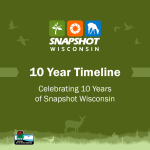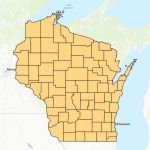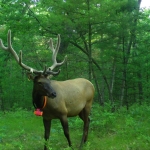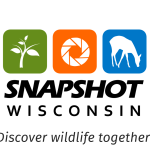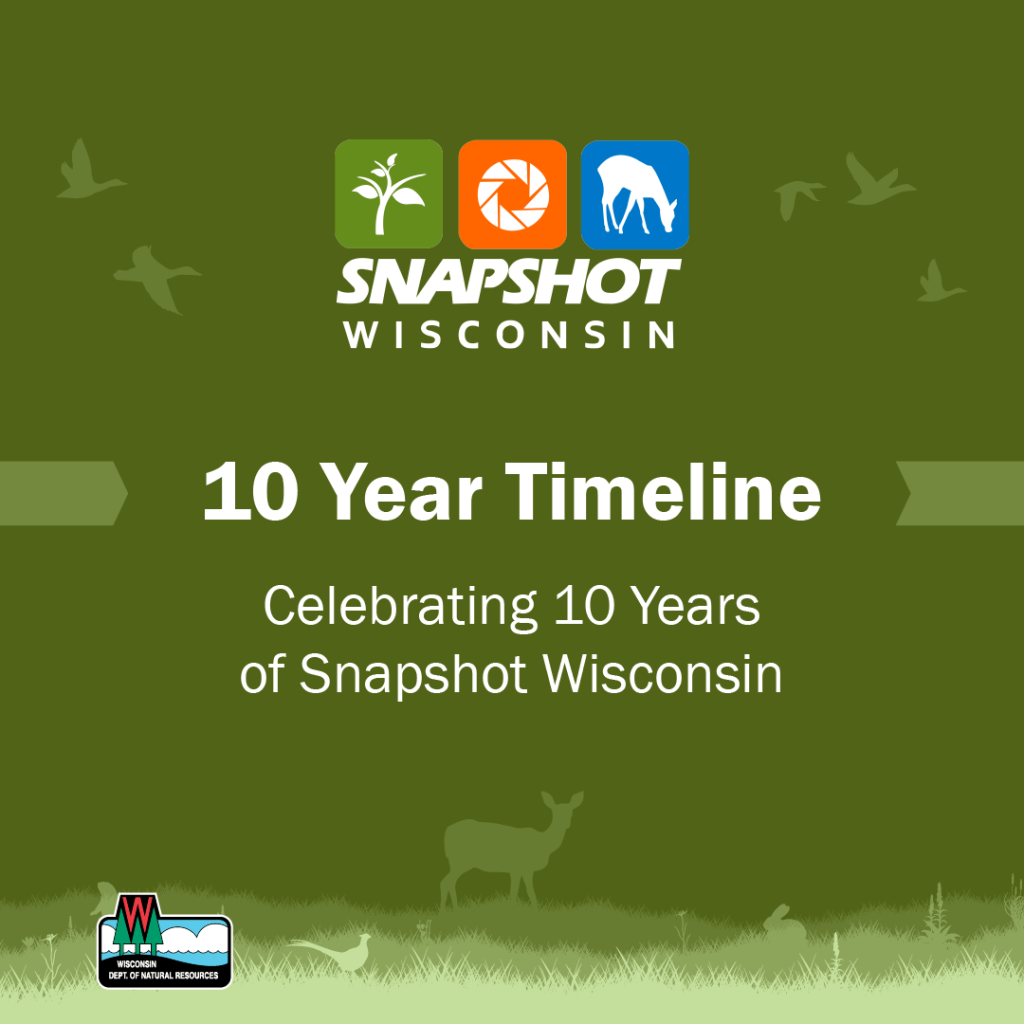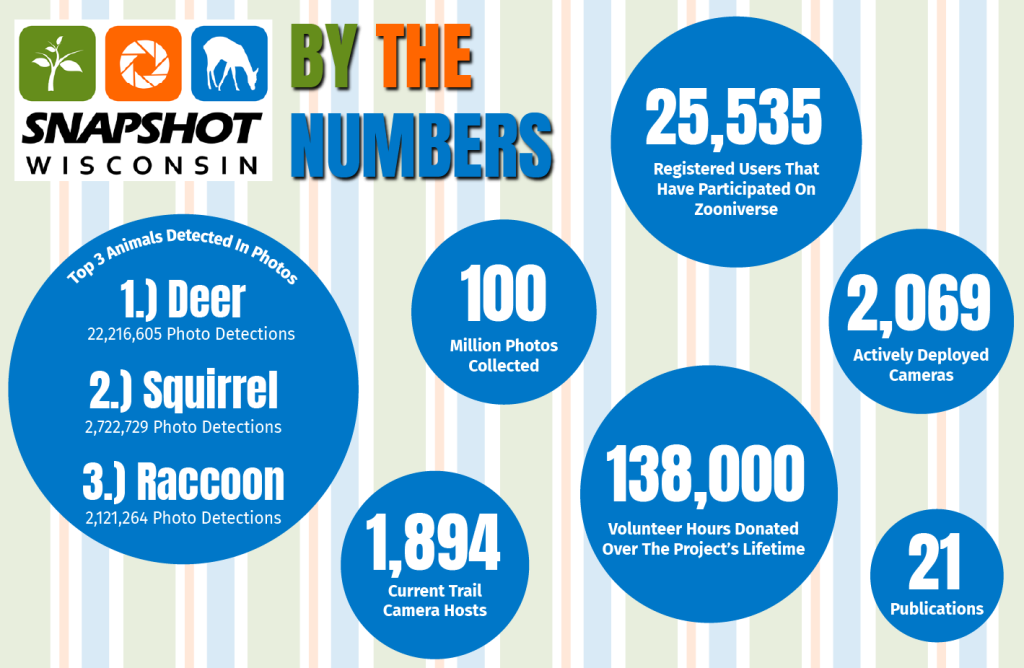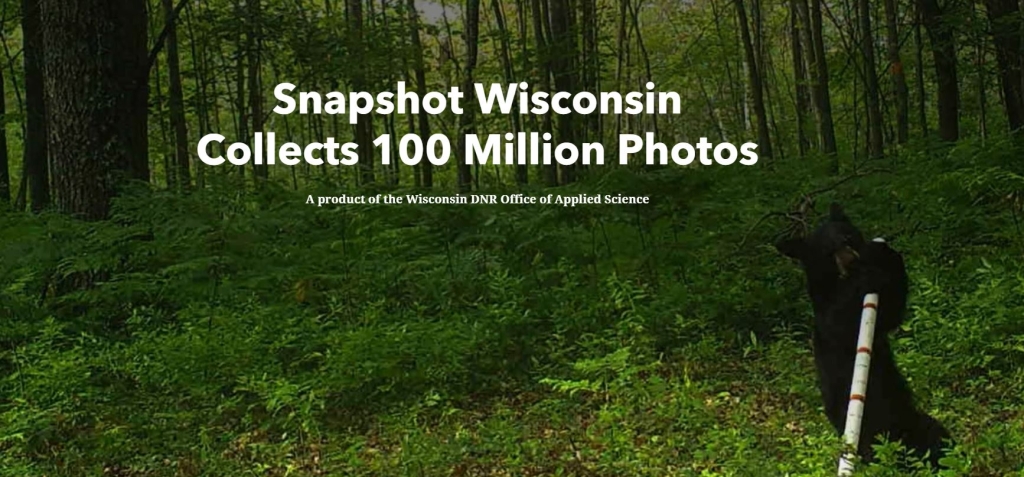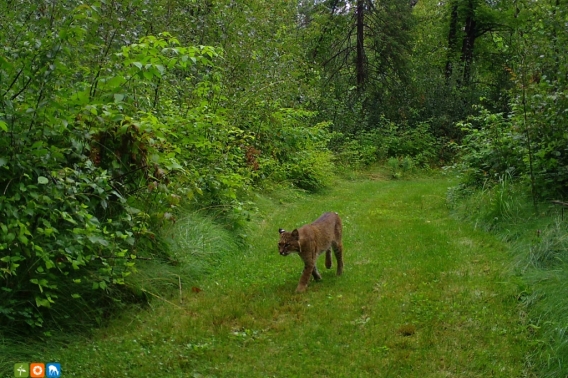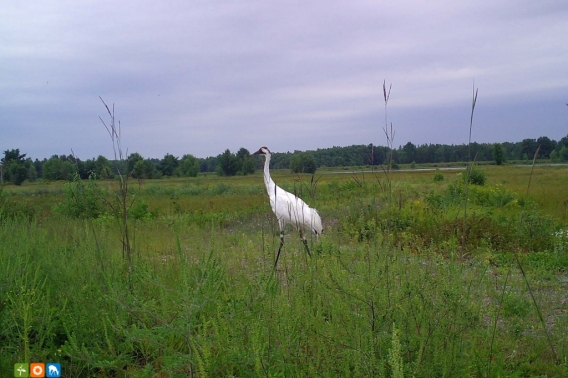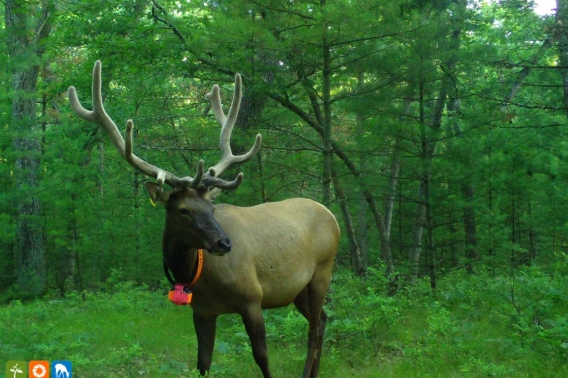Snapshot Newsletter July 2025
Welcome to a special edition of the Snapshot Wisconsin Newsletter! In this edition we are celebrating not one, but two great accomplishments: the 10-year anniversary of Snapshot and reaching 100 million trail camera photos collected. Each of these is a feat in its own right, and neither would have been possible without the dedication and support of each and every one of you. We feel so lucky to do what we do and hope that as you read this edition, you feel a sense of pride in all that you have accomplished.
Would you like to receive Snapshot Wisconsin information and news sooner? Subscribe via GovDelivery and be the first to read the latest happenings with Snapshot Wisconsin and Wisconsin wildlife research.
Snapshot Wisconsin Trail Camera Project - Sign up for emails about new Snapshot Wisconsin newsletters.
Snapshot Wisconsin Educator's Bulletin - Sign up for emails about using Snapshot in classroom and outreach.
Snapshot Through The Years And By The Numbers
Travel back through time and explore Snapshot's milestones by year. Then, check out some of impressive metrics the project has achieved over the past decade.
Story Map Highlights 100 Million Photos Collected
Visit a new, interactive webpage where you can explore Wisconsin, county by county, through the lens of the Snapshot Wisconsin trail camera project!
A Decade Of Data: Snapshot's Contributions To Management
Read this article to find out just a few ways Snapshot data has contributed to wildlife management since 2015.
Snapshot's lead scientists, Dr. Christine Anhalt-Depies and Dr. Jennifer Stenglein, send a heartfelt thank you to anyone who has ever volunteered with Snapshot over the years.
Snapshot Through The Years
Prior to 2015, Snapshot Wisconsin had been an idea, but that idea began to come into fruition thanks to WI DNR funding and a NASA community science grant received by the University of Wisconsin-Madison in 2013. This collaboration laid the groundwork for a program which would be overseen by the WI DNR, that eventually became the Snapshot Wisconsin we all know today. So, after a couple years of planning and backyard trials by Snapshot’s own Dr. Jennifer Stenglein and Dr. Christine Anhalt-Depies, the program was finally able to hit the ground running. Check out some of the key milestones from then to now!
- 2015 – Snapshot launches, placing several hundred trail cameras across the newly established elk reintroduction areas and finding its first volunteers
- Late 2015 – Snapshot enrolls it’s first 10 educators through collaboration with Wisconsin Society of Science Teachers (WSST)
- Early 2016 – Snapshot begins a larger pilot in two Wisconsin counties: Sawyer and Iowa
- Mid 2016 – The program’s first classification season is launched on the Zooniverse crowdsourcing platform
- Late 2016 – Snapshot expands to nine counties (+ Iron, Jackson, Manitowoc, Waupaca, Dodge, Racine and Vernon)
- 2017 – Snapshot starts contributing data towards fawn-to-doe ratios for each Wisconsin Deer Management Unit (DMU). This contribution continues annually*
- Late 2017 – Snapshot has over 1,000 volunteers operating trail cameras in 18 counties
- 2018 – Snapshot expands statewide and begins accepting volunteer applications from all 72 counties
- 2019 – The first research paper utilizing Snapshot data is published, four more research papers follow later that year
- 2020 – The Data Dashboard is made available to the public
- Late 2020 – Snapshot hits 50 million photos collected
- 2022 – Snapshot begins sharing data with the Furbearer Advisory Committee (FAC) to help inform hunting and trapping quotas. This continues annually*
- 2024 – The Snapshot Photo Library is launched
- Mid 2025 – Snapshot celebrates its 10-year anniversary and 100 million photos collected
*Read “A Decade of Data” below for more information on these items.
Snapshot Wisconsin By The Numbers
To view some of the publications Snapshot Wisconsin data has contributed to, you can check out the Snapshot Wisconsin Publications homepage.
Story Map Highlights 100 Million Photos Collected
100 million photos collected is no small feat, and the volunteer hours which made it all possible cannot be overstated. These photos have provided critical data to help inform countless wildlife management decisions, provided educational opportunities for students across the state and engaged thousands of volunteers in community science. To celebrate this achievement, we have put together a photo collection featuring one trail camera image from each county in Wisconsin. Check it out and scroll to explore our state, county by county, through the lens of the Snapshot Wisconsin trail camera project!
*This story map is best viewed on a desktop browser or tablet.
A Decade Of Data: Snapshot’s Contributions To Management
Over the past 10 years, Snapshot Wisconsin has only grown in its capacity to inform wildlife management decisions. With over 2,000 trail cameras currently active, the data we have been able to provide has proven invaluable. From fawn-to-doe ratios for white-tailed deer, decision support data for elk and wolves, to trend reports for furbearers, it’s important for us to emphasize just how meaningful every contribution has been in the larger scope of stewarding our natural resources. Read on to learn about just a few ways Snapshot has been able to contribute to Wisconsin’s wildlife management over the last decade!
Fawn-to-doe Ratios
Beginning in 2017, Snapshot Wisconsin began contributing data to Wisconsin’s County Deer Advisory Councils (CDAC) to help inform county-specific fawn-to-doe ratios. Fawn-to-doe ratios are a metric which estimates how many fawns are present for each doe on the landscape. The higher the ratio, the more fawns have likely survived, and vice versa. These estimates are crucial for CDACs so that they can have a solid grasp on local white-tail recruitment, or how many new deer are being added to the population each year. This then aids them when setting harvest recommendations for future hunting seasons. While there are other inputs informing these fawn-to-doe ratios (Summer Deer Observation Surveys and Operation Deer Watch), Snapshot Wisconsin data helps to fill in the gaps and make this information more robust. Furthermore, the data Snapshot is able to share has only gotten more comprehensive with time. In 2017, 45,230 photos of fawns and does from 675 trail cameras provided data that was then analyzed and shared with the CDACs. Fast forward to 2023, and those numbers jumped to an astounding 110,850 photos from 1,322 cameras.
Snapshot continues to contribute to this dataset annually, and the resulting ratios can be found on the WI DNR’s Deer Metric’s Page.
Furbearer Advisory
In 2022, Snapshot began providing data to the Furbearer Advisory Committee (FAC) in a similar capacity to how they had with the CDACs. The FAC’s purpose, like the CDACs, is to review relevant data and make management decisions for Wisconsin’s furbearer species.
In 2022 Snapshot presented data to the FAC on just two species, bobcats and fishers. At that time, the data provided was the monthly average of Snapshot trail camera detections for both bobcat and fisher, going back to 2018. What’s more, Snapshot scientists were also able to show spatial trends, or where in the state these detections were occurring. Proving informative, these trends were then able to supplement existing information and inform management decisions for the following year.
Because this was a success, these detection trends have continued to be shared with the FAC annually and have even grown to include more species overtime. In the most recent 2024 report, Snapshot was able to share observation trends on 10 furbearer species: beaver, bobcat, coyote, fisher, grey fox, red fox, opossum, otter, raccoon and skunk. As Snapshot grows, we look forward to continuing this important collaboration with the FAC.
Rare Species
From time to time, rare species are also spotted on Snapshot Wisconsin trail cameras. While not only exciting to see, these sightings also provide crucial information to the WI DNR’s Bureau of Natural Heritage Conservation (NHC). NHC is tasked with protecting and restoring our state’s rare plant and animal species, including those which are endangered or threatened at the federal or state level. So, when one of these rare species in seen on a Snapshot camera, the observation is reported to NHC’s Natural Heritage Inventory, a database which tracks occurrences of rare species. Anyone can submit an observation, but the sheer number and statewide dispersal of Snapshot trail cameras make them an especially valuable tool. In 2024 alone, Snapshot was able to submit observations of three rare species (the American marten, moose, and whooping crane) to NHC, and we look forward to continuing this collaboration well into the future.
Additional Support Products
Over the years, Snapshot has also provided decision support products for elk and wolves. For elk, detection information was provided from three distinct study areas: Clam Lake and Flambeau River (northern herd) and Black River Falls (central herd). Snapshot was also able to share photos of unique Bull Elk (males) that they were seeing on the trail cameras. This information is extremely useful as the state aims to both ensure the sustainability of the species, which was reintroduced to Wisconsin in 1995, and set appropriate hunting quotas.
In 2024, Snapshot contributed a year’s worth (April ’23 – April ’24) of wolf detections from the entire trail camera network to be used in the 2024 Grey Wolf Monitoring report. Through this effort, Snapshot was able to provide 90.1% of all verified wolf observations used in the report’s figure below. Grey wolves currently remain classified as federally endangered, however data like this is crucial as the state continues to monitor their activity throughout Wisconsin.
All of these examples are just a brief snippet into how Snapshot Wisconsin has contributed to the management of our state’s wildlife over the past 10 years. From a pilot trail camera in a backyard, to the first volunteer in 2015, to over 2,000 cameras currently deployed, it’s been amazing to watch our capacity grow over time. As we look to the future, we can’t wait to see where we go from here, and what positive contributions we can make to science and Wisconsin wildlife in the process.
Sincerely, Thank You!
A note from Snapshot’s Dr. Christine Anhalt-Depies and Dr. Jennifer Stenglein:
"Ten years ago, we were accepting our very first volunteers into the Snapshot Wisconsin program. We traveled to Sawyer and Iowa counties, conducting in-person trainings, meeting you all for the first time. We partnered with educators and were excited about the reach that Snapshot Wisconsin could have into classrooms. We were thrilled to see the very first photos come rolling in, excited about what we would learn. A couple years later, we expanded the project to 10 counties, and then a year or so after that Snapshot Wisconsin was statewide. We were hopeful that Snapshot Wisconsin would grow, provide high quality information, and bring value to the people of the state.
The reality is that your enthusiasm and dedication to the project has exceeded our expectations. Snapshot Wisconsin has grown into more than we could have imagined. With multiple years of data, this project is useful for tracking Wisconsin’s wildlife populations through time and across the state. Data from Snapshot Wisconsin supports decision making for 14 different species, with more products in development. Snapshot Wisconsin is used in classrooms and nature programs in support of science and environmental education, and this project has impacts far beyond Wisconsin. Research based on Snapshot Wisconsin has resulted in 21 scientific publications. Snapshot Wisconsin data are requested and used by high school students, university researchers, and Wisconsinites for their own curiosity and research questions.
The 100,000,000 photos that you all have helped collect are beautiful, wild, and surprising. We all have our favorites. One of ours comes from the first year of Snapshot Wisconsin. A romp of 8 otters running down a grassy path in Sawyer County. Who even knew otters traveled together over land like this? A volunteer brought it to our attention and commented on how they were surprised. This was the first of so many moments like this. Sharing awe and delight around Wisconsin’s incredible natural resources.
Over 30,000 people make this project possible. Whether you are a trail camera host, assist with classifying photos online, or a general supporter of the project, we are grateful for your contributions. Every day we are reminded of how much the people of our state value our shared natural resources. We are incredibly proud to partner with you all on this unique project. Thank you!”

